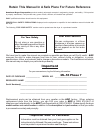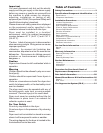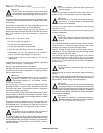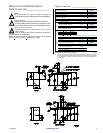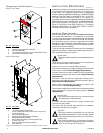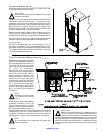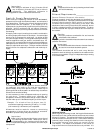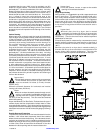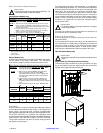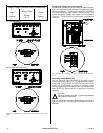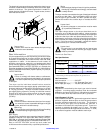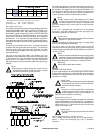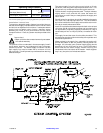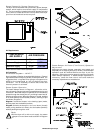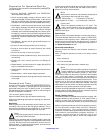
8
American Dryer Corp.
113345-9
!
!
!
!
!
!
Important
For extended ductwork runs, the
cross section area of the
ductwork can only be
increased to an extent. When the
ductwork approaches the maximum
limits noted in this manual, a
professional heating, ventilating, and
air-conditioning (HVAC) firm should be
consulted for proper venting
information.
All ductwork should be smooth inside
with no projections from sheet metal
screws or other obstructions, which will
collect lint. When adding ducts, the duct
to be added should overlap the duct to
which it is to be connected. All ductwork
joints must be taped to prevent moisture
and lint from escaping into the building.
Inspection doors should be installed at
strategic points in the exhaust ductwork
for periodic inspection and cleaning of
lint from the ductwork.
Note
When the exhaust ductwork
passes through a wall, ceiling,
or roof made of combustible
materials, the opening must be 2-inches
(5.08 cm) larger than the duct (all the way around). The duct
must be centered within this opening.
Outside Ductwork Protection
To protect the outside end of the horizontal ductwork from the
weather, a 90° elbow bent downward should be installed
where the exhaust exits the building. If the ductwork travels
vertically up through the roof, it should be protected from the
weather by using a 180° turn to point the opening downward.
In either case, allow at least twice the diameter of the duct
between the duct opening and the nearest obstruction.
Important
Do not use screens, louvers, or caps on the outside
opening of the exhaust ductwork.
Electrical Information ________________
Electrical Requirements
All electrical connections must be made by a properly licensed
and competent electrician. This is to ensure that the electrical
installation is adequate and conforms to local and state
regulations or codes. In the absence of such codes, all
electrical connections, materials, and workmanship must
conform to the applicable requirements of the National
Electrical Code ANSI/NFPA NO. 70-LATEST EDITION or in
Canada, the Canadian Electrical Codes Parts 1 & 2 CSA
C22.1-1990 or LATEST EDITION.
Important
Failure to comply with these codes or ordinances,
and/or the requirements stipulated in this manual
can result in personal injury or component failure.
Note
Component failure due to improper installation will
void the warranty.
Each dryer should be connected to an independently protected
branch circuit. The dryer must be connected with copper
wire only. Do not use aluminum wire; it could create a fire
hazard. The copper conductor wire/cable must be of proper
ampacity and insulation in accordance with electric codes
for making all service connections.
Note
The use of aluminum wire will void the warranty.
An individual ground circuit must be provided to
each dryer, do not daisy chain.
Component failure due to improper voltage application will
void the warranty.
ADC reserves the right to make changes in specifications at
any time without notice or obligation.
Important
A separate protected circuit must be provided to each
dryer.
The dryer must be connected to the electric supply shown on
the data label. In the case of 208 VAC or 230/240 VAC, the
supply voltage must match the electric service specifications
of the data label exactly.
The wire size must be properly sized to handle the related
current.
Warning
208 VAC and 230/240 VAC are not the same. Any
damage done to dryer components due to improper
voltage connections will automatically void the
warranty.
!
!



